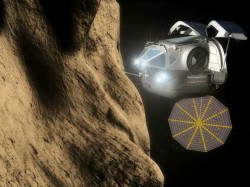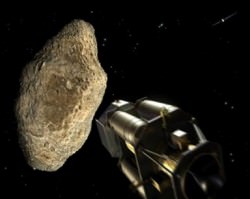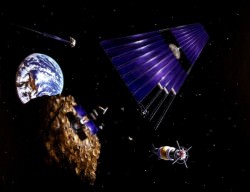We can’t just go into space with a big butterfly net or catcher’s mitt, so how in the world could we capture an asteroid?
Ah asteroids, those dinosaur-killing, Scrooge-McDuck-moneybins from heaven.
They’re great and all, but you know what would be better? All the asteroids gathered up and put in a nice safe orbit where we harvest out all their precious sweet, juicy platinum cores.
Instead of nervously scanning the heavens, wishing we had more iridium at our disposal, we could seek out all the asteroids in the Solar System and push them somewhere we can get at them, whenever we want after we dump them into the orbital equivalent of a lazy susan.
Okay fine, instead of pushing all the asteroids around, maybe we should start with one. Get that right and we can extend our plans to the rest of the delicious space rocks we crave.
I know this sounds like just another pie in the sky “Fraser-Cain-double-plus-crazy” plan, but I’m not the only one to propose this idea. In fact, NASA has expressed plans to reach out and capture an asteroid and maybe put it into orbit around Earth.
There are many benefits to this plan. We’ll learn just how hard it is to move asteroids around, should we find one on a dangerous trajectory. We’ll learn how to land on an asteroid, and extract its precious resources. And of course, there’s the science. So much to learn from a pet asteroid. Also, if anyone ticks us off we can lop off clumps and hurl it at them. So a dinosaur killing space rock, returned safely to Earth? That sounds a little dangerous. Possibly a species-wide Darwin awards moment.

How exactly does one capture an asteroid, and how could we move it back to Earth without killing us all, and more importantly will the Aliens have Darwin awards when we accidentally wipe ourselves out? This sounds like a job for BRUCE WILLIS.
As you may suspect, scientists have come up with a vast collection of clever ideas to move asteroids around. They all come down to the same challenge. You somehow need to impart a thrust to an asteroid. NASA has also informed me that involving Bruce Willis is optional, despite my insistence and extensive letter writing campaign.
One basic idea would be to fly down to the asteroid and install some kind of thruster on it. Perhaps an efficient ion engine, or a rail gun that throws off chunks of rock into space, imparting a thrust to the asteroid. The problem is that asteroids are often spinning, so you’d need to stop that rotation before you could fire up the thrusters.

Another idea would be to set off nuclear explosions nearby and just push it in the right direction with raw explosive power. By setting off the nuke close enough to the asteroid’s surface, you expel vaporized rock, which acts like a thruster. Also known as the “Ben Affleck Special”.
This one’s going to sound crazy, but scientists are serious. Airbags. You could bump a large inflated bag against the asteroid again and again to slowly nudge it in the direction you want. The rotation doesn’t really matter because the time you contact the asteroid is so brief.
Don’t like that? How about a gravity tractor? Now I’ve got your attention! You could fly a spacecraft really close to the asteroid, which would then attract it slowly, pulling it in the direction you like. As long as the spacecraft keeps thrusting away from the asteroid, you’ll keep pulling it along like a kite on a string.
These are just some of the big ideas. Scientists have proposed some sort of one sided space graffiti, painting them silver, possibly attaching solar sails, or even vaporizing rock with lasers to provide thrust.

There’s another idea which deserves mention, and I’m going to warn you right now, it’s pretty terrifying. It’s called aerobraking. Instead of using energy to slow the asteroid and put it into the perfect orbit, we use the Earth’s atmosphere to help asteroids shed a tremendous amount of velocity.
By allowing an asteroid to pass briefly – briefly! – through the atmosphere of the Earth, you could decelerate it significantly. Make a few of these passes and you should be able to get it into a nice safe orbit around Earth. Of course, get it wrong and you crash an asteroid into Earth. So, there’s that. It would absolutely make a mess of our lawn, and we’d be the laughing stock of the local group.
Asteroids are precious resources, just waiting for us to reach out and harvest their minerals. Fortunately, we’ve got a range of strategies we can use to move them around. One of them has got to work… right?
Which idea for moving an asteroid do you like the best? Which one really freaks you out?


(quote)Also, if anyone ticks us off we can lop off clumps and hurl it at them.(/endquote)
Yeah, jeeze, more space race/arms race…. Exactly what we need. Think getting one in orbit will move the doomsday clock? Wasn’t “The Moon is a harsh mistress” about an independence movement on the moon getting access to an electric asteroid “gun” for mining deliveries to earth orbit?
Can you imaging a misfire on mining the asteroid and a chunk get’s the right kick to dive it on the planet? Talk about industrial accidents….
On the other hand maybe we’ll have to work harder to get our act together as a planet and make peace. At least you got the darwin-prize award for the aliens watching right. Aerobracking… vs global warming vs… a solar flare which gives no warning and knocks the atmosphere around …. o so much fun we could have looking for meteorites as the world ends….
Changing the orbit of an asteroid is like changing the formation of a mountain. The Alps are just a few million years old. Moving an asteroid to Earth orbit is like sculpturing Mont Blanc to a statue looking like a naked girl made out of bronze on a city center square, by moving some dirt on the ground through which it will slowly tectonically emerge. It’s not a working plan in a human mind. One can do the math, but one cannot actually do it. (Unless someone around here has an ingenious plan)
The point of it all is to extract (mine) the resource – so build a factory that does that, instead of complicating the process by transporting it here. After the science is done, that’s the goal, anyway, right? Extract the goodies? The challenge, right now, is just a temporary goal; find a few over the next few decades for investigation and transport/divert them into Earth’s orbit. Do the mining or whatever, later… Maybe the better solution is just to simply bring back large chunks of a few of them for analysis instead of an entire half-mountain. And, they aren’t all the same, either. An in-situ analysis will have be done, anyway, upon arrival to find out if it’s worth beyond the science. I’m thinking of a Curiosity-Philae combo… Something like a lander-laboratory that confirms mineral/resource value of an object before mining it, instead of expending much energy to transport it into orbit only to find, quite possibly, that the thing has so many structural weaknesses that it wouldn’t be able to tolerate, say, a “tight orbit” around the Earth. It’d be rather uncomfortable to pay damages on a fragmented comet with so many pieces raining down. I say keep it where it is, and send a laboratory robot for the first few missions, and manned, of course, later, to analyze it further, and if needs be, bring it into a wide orbit around the Moon, not Earth.
Why move the asteroid? Build a robotic mining station and send it to the asteroid with a human crew. Anchor it to the rock and leave it to dismantle and sort the ore. Send crewed ships to pick up the valuables and transport them home, while the station continues mining. Once we have what we want, send the miner on to the next asteroid. Of course, there would be a lot more involved, but we would only need to move the valuables, and we would end up with a nice inventory of what was still out there.
I vote for LASER or MASER ablation. To get enough power for this technique to work we’d probably have to fly a fission reactor? That is if we are to assume capture would happen somewhere between the orbits of Mars and Jupiter? First, we’d have to get there in a reasonable amount of time, then we’d need to do consecutive burns to slow/stop rotation(s) and then more burns to alter the orbit… ZAP! ZAP! ZAP! ZAP! ZAP!
The amount of energy required to significantly change the orbit of an asteroid of any real size (e.g. 1km diameter or bigger) would be enormous. Add to this the risk of impact if the orbital change goes awry … and you are right, the Darwin Award would be “in the bag”.
Postman1’s suggestion of a robot miner sent to the asteroid is much more reasonable.
Regards,
Tony Barry
The trick is to deflect the asteroid several years before it crosses the Earth-Moon system, and pick a trajectory where the Moon will gravity-assist the asteroid down to an Earth orbit.
In orbital mechanics, time acts as a lever. Doing the maneuver early enough allows to change the trajectory of big asteroids with small thrust.
Then no rocket is strong enough to brake a big asteroid entering Earth’s vicinity. But the Moon is. Gravity assist can work both ways : make a flyby behind the Moon, and you gain speed from its angular velocity. Make a flyby in front of it, and you will slow down.
Try it in Kerbal Space Program’s Asteroid Redirect Mission, it works 🙂